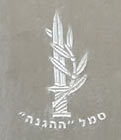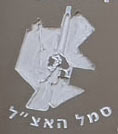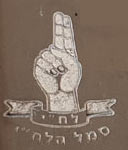Historical background
In Petah Tikva, the 3 undergrounds operated: the Haganah, the Etzel and the Lehi.
 Haganah
Haganah (The Haganah symbol is taken from one of the signs in the series)
The largest and most institutional military organization of the three undergrounds. The Haganah was established in 1920 to provide protection against Israeli Arab attacks on the Jewish community. During World War II, the organization collaborated with the British against the danger of the Nazis invading Israel, but at the end of the war, the organization turned its efforts against the British rule in Israel.
The military force of the Haganah - the Palmach - crushing companies - was established in 1931 under the command of Yitzhak Sadeh.
The Haganah also acted extensively in the field of illegal immigration, mainly through the Palyam units (including Operation Boatswain

) and the Hagid’onim (the Haganah’s communication unit)

With the declaration of the State of Israel, the IDF was established mainly on the basis of the Haganah forces.
Among the commanders of the Haganah were: Eliyahu Golomb, Yitzhak Sadeh, Israel Galili, Moshe Sneh and more.
Many Petah Tikva residents enlisted in the Haganah organization. The new members were sworn in at the workers’ loan fund

 Etzel
Etzel (Etzel emblem is taken from one of the signs in the series)
Etzel (Irgun) - an acronym for the National Military Organization. The Etzel, which advocated more decisive action against the British than the Haganah, was established in Jerusalem in 1931 and consisted mainly of members of the Betar movement and the Revisionist movement led by Ze’ev Jabotinsky.
The Irgun was considered by the British to be a terrorist organization, and pursued its leaders and soldiers. Many of its soldiers were placed in detention camps in Latrun and Eritrea, and some were even hanged.
During World War II, the Irgun’s actions against the British provoked controversy among the Haganah leadership, which collaborated with the British in their war against the Nazis, which led to The "Saison" (hunting season) - the imprisonment and extradition of Irgun activists to the British authorities.
One of the Irgun’s well-known actions that provoked controversy was the explosion of the King David Hotel in Jerusalem, which housed the Mandate headquarters, in which 90 people were killed, including 15 Jews.
Following the declaration of the State of Israel on November 29, in which the UN decided on the partition plan and the end of the British Mandate, there was a rapprochement between the Haganah and the Irgun, despite incidents in various places between the two organizations.
After the declaration, Etzel forces in IDF units were usually integrated into independent units, all of which were composed of their own men. In June 1948, the Irgun brought an arms ship from France (Altalena) on board were also immigrants destined to serve in the Irgun units. Due to a dispute over the distribution of the weapons on the ship (whether most of it will belong to the IDF, or to the Irgun forces that were already in the IDF), and due to fears of a civil war, Ben-Gurion ordered the ship to be shelled and it sank.
The Irgun units within the IDF were scattered among the various units.
Among the Irgun commanders were: David Raziel, Yaakov Meridor, Menachem Begin. The supreme (ideological) commander was Zeev Jabotinsky.
The base of the Irgun members in Petah Tikva was in the Spiegel field, from where they went out to paste leaflets and other activities

.
The Irgun commander Menachem Begin (in 1944) lived in Petah Tikva for a while, two months after he moved from Jerusalem to Tel Aviv. He stayed in Petah Tikva in various places for about 9 months, until he returned to Tel Aviv.
 Lehi
Lehi (The Lehi symbol is taken from one of the signs in the series)
Lehi - An acronym for Herut Israel Fighters. Lehi was considered the most militant of the three undergrounds. The underground was established in 1940 by Irgun members who did not agree to cooperate with the British in their war against the Nazis. The underground was established by Avraham Stern ("Yair") who was assassinated by a British detective during his arrest.
The Lehi was considered by the British to be a terrorist organization (the Stern gang), and pursued its leaders and soldiers. Many of its soldiers were placed in detention camps in Latrun and Eritrea, and some were even executed by hanging.
The Lehi’s actions were explosions in British centers of government, but also in civilian places (mainly concentrations of Arab residents), assassinations of British government officials and soldiers, attacks on railways, army camps and more.
With the establishment of the state, Lehi units were integrated into the IDF.
Among the Lehi commanders are: Avraham Stern ("Yair"), Yitzhak Shamir, Israel Scheib-Eldad, and more.
In Petah Tikva, there was a relatively small presence of the underground. One of the known actions was the release of the Lehi girls who were imprisoned by the Petah Tikva Police

About the signs
The signs consist of a rectangular metal panel and around it a frame that ends at the pillar. On the board are the symbols of the municipality and the immortalized organization.


 Haganah (The Haganah symbol is taken from one of the signs in the series)
Haganah (The Haganah symbol is taken from one of the signs in the series)  Etzel (Etzel emblem is taken from one of the signs in the series)
Etzel (Etzel emblem is taken from one of the signs in the series)  Lehi (The Lehi symbol is taken from one of the signs in the series)
Lehi (The Lehi symbol is taken from one of the signs in the series)